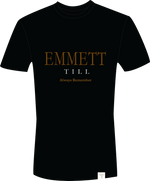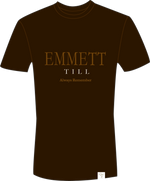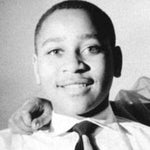Cotton Blocks
The Emmett
Fine Jersey 100% Combed Ring-Spun Cotton
Small Batch Printing
Our screen printed hoodies & tees are printed in small batches!
Orders ship within 1 week of order date, you will receive a shipping notification.
Backorder Order Option
Out of stock size/color can be ordered with the "backorder" option under the 'size' button when available. These items will be printed and shipped within 30 days. Cotton Blocks screen-prints our own tees & hoodies, we do not manufacture the tees and hoodies, we rely on the inventory of our fabulous partners and backordering options are based on that expected availability.
Care Instructions
- Machine wash warm, inside out with like colors
- Only non chlorine bleach
- Tumble dry low
- Medium Iron
- Do not iron screen print
- Do not dry clean
100 % No Sweatshops & Eco-Friendly
*Models wearing desert pink and warm gray
Always Remember Emmett (1941-1955)
The brutal abduction and murder of 14-year-old Emmett Till on August 28, 1955, galvanized the emerging civil rights movement.
Who Was Emmett Till?
Emmett Till was born in Chicago and grew up in a middle-class Black neighborhood. Till was visiting relatives in Money, Mississippi, in 1955 when the fourteen-year-old was accused of whistling at Carolyn Bryant, a white woman who was a cashier at a grocery store.
Four days later, Bryant's husband Roy and his half-brother J.W. Milam kidnapped Till, beat him and shot him in the head. The men were tried for murder, but an all-white, male jury acquitted them.
Till's murder and open casket funeral galvanized the emerging civil rights movement. More than six decades later, in January 2017, Timothy Tyson, author of The Blood of Emmett Till and a senior research scholar at Duke University, revealed that in a 2007 interview Carolyn admitted to him that she had lied about Till making advances toward her.
In 2018, the Justice Department said that it had received “new information” about Till’s death, and the FBI reopened an investigation into his murder.
Mother and Father
Till was the only child of Louis and Mamie Till. Till's mother was, by all accounts, an extraordinary woman. Defying the social constraints and discrimination she faced as an African American woman growing up in the 1920s and '30s, Mamie excelled both academically and professionally.
She was only the fourth Black student to graduate from suburban Chicago's predominantly white Argo Community High School, and the first Black student to make the school's "A" Honor Roll. While raising Till as a single mother, she worked long hours for the Air Force as a clerk in charge of confidential files.
Till never knew his father, a private in the United States Army during World War II. Till was born in 1941; his parents separated in 1942. Three years later, Mamie received word from the Army that Louis had been executed for "willful misconduct" while serving in Italy.
Childhood
Till, who went by the nickname Bobo, was born on July 25, 1941, in Chicago. He grew up in a thriving, middle-class Black neighborhood on Chicago's South Side. The neighborhood was a haven for Black-owned businesses, and the streets he roamed as a child were lined with Black-owned insurance companies, pharmacies and beauty salons as well as nightclubs that drew the likes of Duke Ellington and Sarah Vaughan.
Those who knew Till best described him as a responsible, funny and infectiously high-spirited child. He was stricken with polio at the age of 5. He managed to make a full recovery, save a slight stutter that remained with him for the rest of his life.
With his mother often working more than 12-hour days, Till took on his full share of domestic responsibilities from a very young age. "Emmett had all the house responsibility," his mother later recalled. "I mean everything was really on his shoulders, and Emmett took it upon himself. He told me if I would work, and make the money, he would take care of everything else. He cleaned, and he cooked quite a bit. And he even took over the laundry."
Till attended the all-Black McCosh Grammar School. His classmate and childhood pal, Richard Heard, later recalled, "Emmett was a funny guy all the time. He had a suitcase of jokes that he liked to tell. He loved to make people laugh. He was a chubby kid; most of the guys were skinny, but he didn't let that stand in his way. He made a lot of friends at McCosh."
In August 1955, Till's great uncle, Moses Wright, came up from Mississippi to visit the family in Chicago. At the end of his stay, Wright was planning to take Till's cousin, Wheeler Parker, back to Mississippi with him to visit relatives down South, and when Till, who was just 14 years old at the time, learned of these plans, he begged his mother to let him go along.
Initially, Till's mother was opposed to the idea. She wanted to take a road trip to Omaha, Nebraska, and tried to convince her son to join her with the promise of open-road driving lessons.
But Till desperately wanted to spend time with his cousins in Mississippi, and in a fateful decision that would have grave impact on their lives and the course of American history, Till's mother relented and let him go.
Death
On August 28, 1955, Till was murdered for being accused of offending a white woman working in her family’s grocery store.
On August 19, 1955—the day before Till left his home in Chicago with his uncle and cousin for Mississippi—Mamie Till gave her son his late father's signet ring, engraved with the initials "L.T."
The next day she drove her son to the 63rd Street station in Chicago. They kissed goodbye, and Till boarded a southbound train headed for Mississippi. It was the last time they ever saw each other.
Three days after arriving in Money, Mississippi — on August 24, 1955 — Till and a group of teenagers entered Bryant's Grocery and Meat Market to buy refreshments after a long day picking cotton in the hot afternoon sun.
What exactly transpired inside the grocery store that afternoon will never be known. Till purchased bubble gum, and in later accounts he was accused of either whistling at, flirting with or touching the hand of the store's white female clerk—and wife of the owner—Carolyn Bryant.
Four days later, at approximately 2:30 a.m., Roy Bryant, Carolyn's husband, and his half brother J.W. Milam kidnapped Till from Moses Wright's home. They then beat the teenager brutally, dragged him to the bank of the Tallahatchie River, shot him in the head, tied him with barbed wire to a large metal fan and shoved his mutilated body into the water.
Moses Wright reported Till's disappearance to the local authorities, and three days later, his corpse was pulled out of the river. Till's face was mutilated beyond recognition, and Wright only managed to positively identify him by the ring on his finger, engraved with his father's initials—"L.T."
“It never occurred to me that Bobo would be killed for whistling at a white woman.” — Simeon Wright, Emmett Till's cousin
“It would appear that the state of Mississippi has decided to maintain white supremacy by murdering children.” — Roy Wilkins, head of the NAACP
Open-Casket Funeral
Till's body was shipped to Chicago, where his mother opted to have an open-casket funeral with Till's body on display for five days. Thousands of people came to the Roberts Temple Church of God to see the evidence of this brutal hate crime.
Till's mother said that, despite the enormous pain it caused her to see her son's dead body on display, she opted for an open-casket funeral in an effort to "let the world see what has happened, because there is no way I could describe this. And I needed somebody to help me tell what it was like."
"With his body water-soaked and defaced, most people would have kept the casket covered. [His mother] let the body be exposed. More than 100,000 people saw his body lying in that casket here in Chicago. That must have been at that time the largest single civil rights demonstration in American history." — Jesse Jackson
Till’s casket is now on display at the Smithsonian's National Museum of African American History and Culture in Washington, D.C.
Photos of Till’s Body
In the weeks that passed between Till's burial and the murder and kidnapping trial of Roy Bryant and J.W. Milam, two Black publications, Jet magazine and the Chicago Defender, published graphic photos of Till's corpse.
By the time the 1955 trial for Till's killing began, his murder had become a source of outrage and indignation throughout the country.
Murder Trial
The trial against Till's killers began on September 19, 1955. Because Black people and women were barred from serving jury duty, Bryant and Milam were tried before an all-white, all-male jury.
In an act of extraordinary bravery, Moses Wright took the stand and identified Bryant and Milam as Till's kidnappers and killers. At the time, it was almost unheard of for Black people to openly accuse white people in court. By doing so, Wright put his own life in grave danger.
Despite the overwhelming evidence of the defendants' guilt and widespread pleas for justice from outside Mississippi, on September 23, the panel of white male jurors acquitted Bryant and Milam of all charges. Their deliberations lasted a mere 67 minutes.
Killers
In January 1956, Roy Bryant, the husband of Till’s accuser Carolyn, and his half-brother, J.W. Milam, admitted to committing the murder of Till. Protected by double jeopardy laws, they told the whole story of how they kidnapped and killed Till to Look magazine for $4,000.
"J.W. Milam and Roy Bryant died with Emmett Till's blood on their hands," Simeon Wright, Till's cousin and an eyewitness to his kidnapping (he was with Till the night he was kidnapped by Milam and Bryant), later stated. "And it looks like everyone else who was involved is going to do the same. They had a chance to come clean. They will die with Emmett Till's blood on their hands."
Impact on Civil Rights
"I thought about Emmett Till, and I couldn't go back [to the back of the bus]." — Rosa Parks
Coming only one year after the Supreme Court's landmark decision in Brown v. Board of Education mandated the end of racial segregation in public schools, Till's death provided an important catalyst for the American civil rights movement.
One hundred days after Till's murder, Rosa Parks refused to give up her seat on an Alabama city bus, sparking the yearlong Montgomery Bus Boycott. Nine years later, Congress passed the Civil Rights Act of 1964, outlawing many forms of racial discrimination and segregation. In 1965, the Voting Rights Act, outlawing discriminatory voting practices, was passed.
[Emmett Till's murder was] one of the most brutal and inhuman crimes of the 20th century. — Martin Luther King Jr.
Though she never stopped feeling the pain of her son's death, Mamie Till (who died of heart failure in 2003) also recognized that what happened to her son helped open Americans' eyes to the racial hatred plaguing the country, and in doing so helped spark a massive protest movement for racial equality and justice.
"People really didn't know that things this horrible could take place," Mamie Till said in an interview with Devery S. Anderson, author of Emmett Till: The Murder That Shocked the World and Propelled the Civil Rights Movement, in December 1996. "And the fact that it happened to a child, that make all the difference in the world."
Accuser
In a 2007 interview, Till’s accuser, Carolyn Bryant Donham (she had divorced and remarried), admitted that she had lied about Till making advances toward her.
“That part’s not true,” she told Timothy Tyson, a senior researcher at Duke University. The interview was reported in a 2017 Vanity Fair article upon the publishing of Tyson’s book, The Blood of Emmett Till.
Bryant Donham also told Tyson, “Nothing that boy did could ever justify what happened to him," and admitted she “felt tender sorrow” for his mother.
In the summer of 2018, the Justice Department reportedly reopened the investigation into Till's death with the "discovery of new information."
It was unclear whether the government would bring forth new charges, though recent federal efforts to reexamine racially motivated crimes from the past had occasionally produced results, including the 2010 conviction of a former Alabama state trooper charged with killing activist Jimmie Lee Jackson in 1965.
Painting and the Whitney Biennial
A painting of Till’s casket by white artist Dana Schutz stirred up controversy after it was included at the 2017 Whitney Biennial. The African American artist Parker Bright positioned himself in front of the work in a t-shirt with the words “Black Death Spectacle” printed on the back. He was joined by other protestors, including British-born Black artist Hannah Black.
“The subject matter is not Schutz’s. White free speech and white creative freedom have been founded on the constraint of others, and are not natural rights. The painting must go,” Black wrote in a Facebook message signed by 30 other artists identified as nonwhite.
Documentaries and Movies
Decades after Till’s death, several documentaries and movies have been produced about his life and death. Among the most well-known are the 2003 PBS investigatory documentary The Murder of Emmett Till and the 2005 documentary The Untold Story of Emmett Louis Till by civil rights filmmaker Keith A. Beauchamp.
Upcoming productions include Till, directed by Grey’s Anatomy star Jesse Williams and based on a screenplay by Beauchamp and Michael Reilly; The Face of Emmett Till; and an HBO miniseries produced by Jay-Z, Will Smith and Aaron Kaplan.
Article Title: Emmett Till Biography
Author: Biography.com















